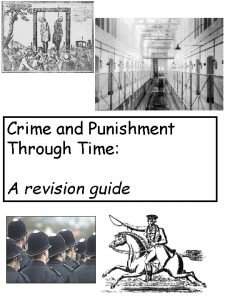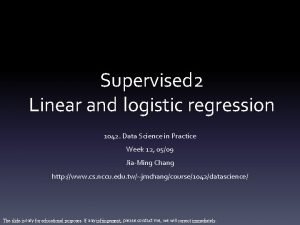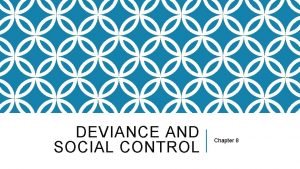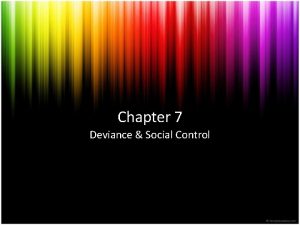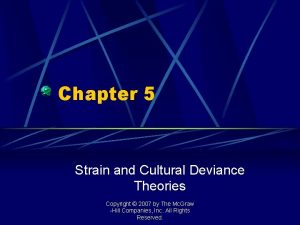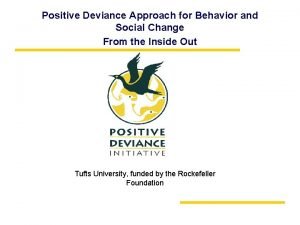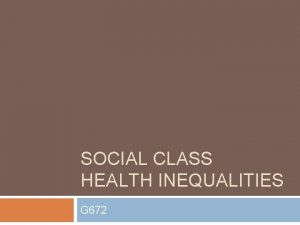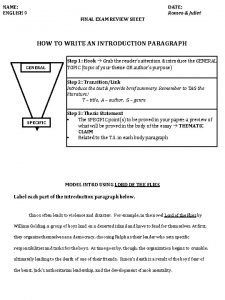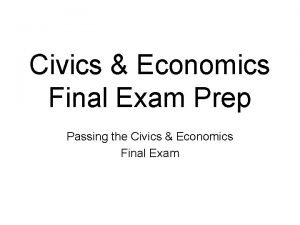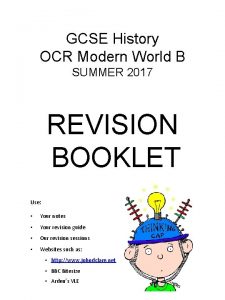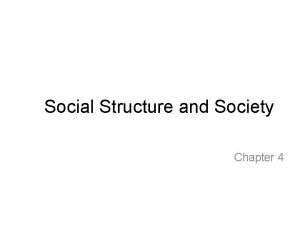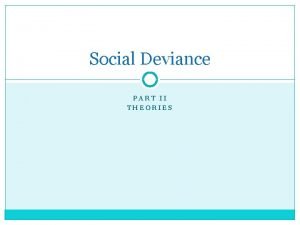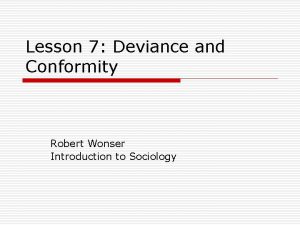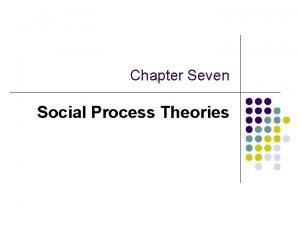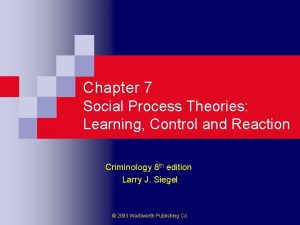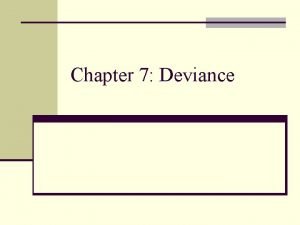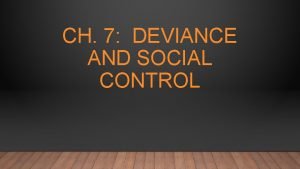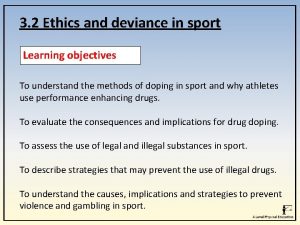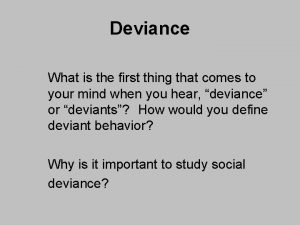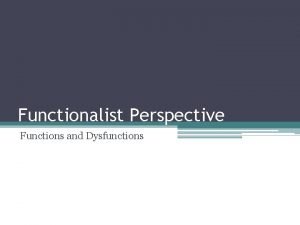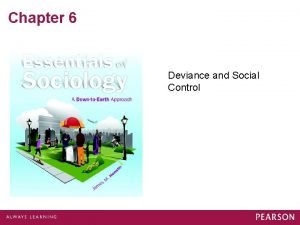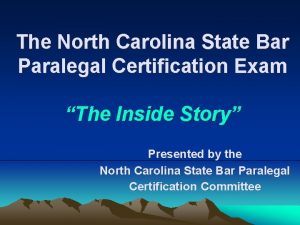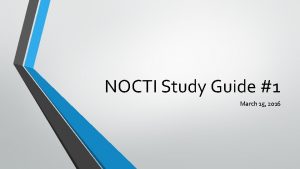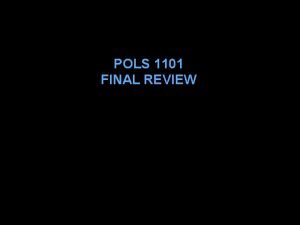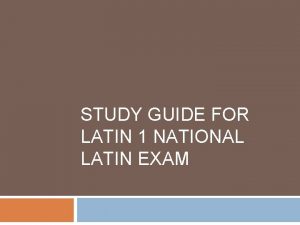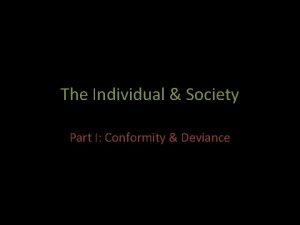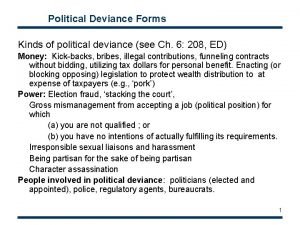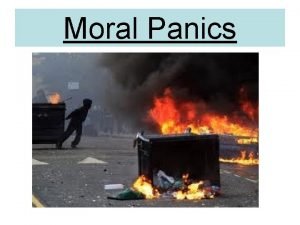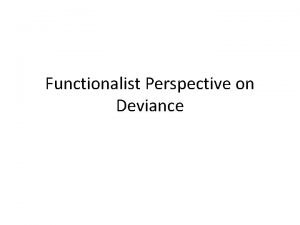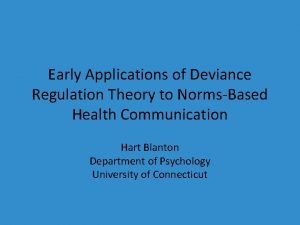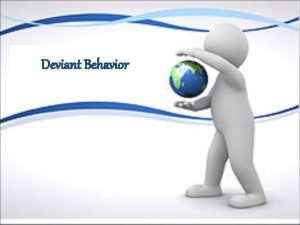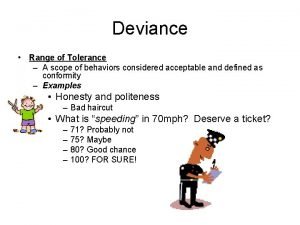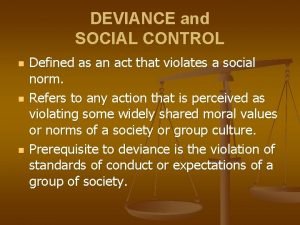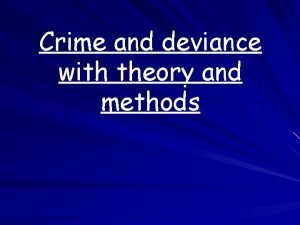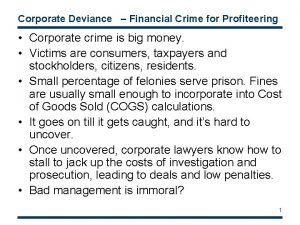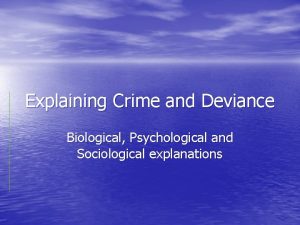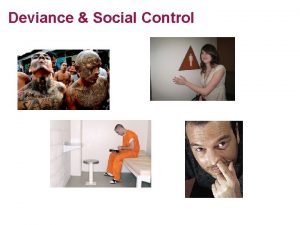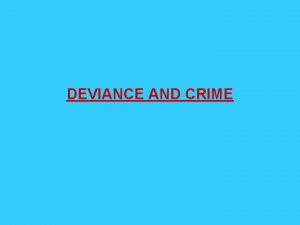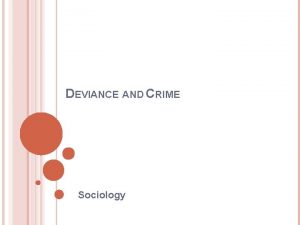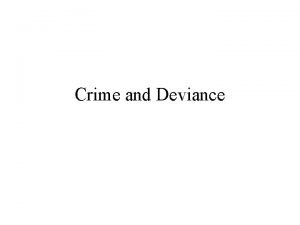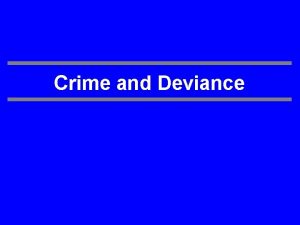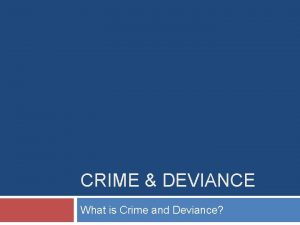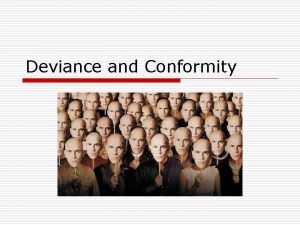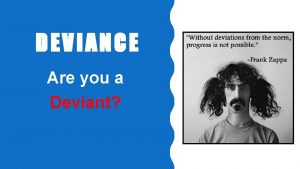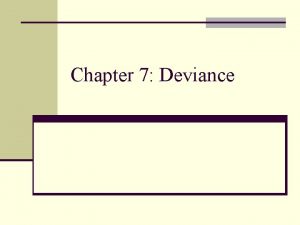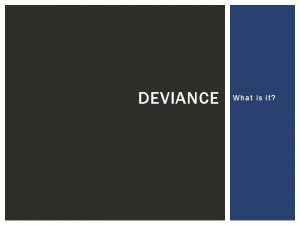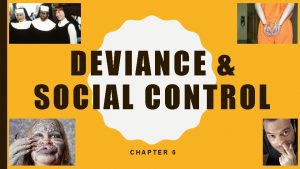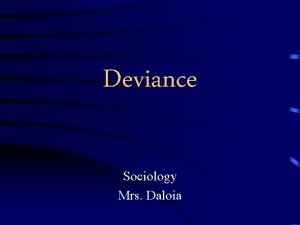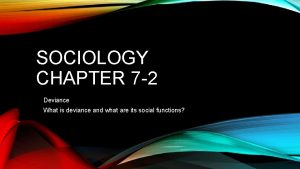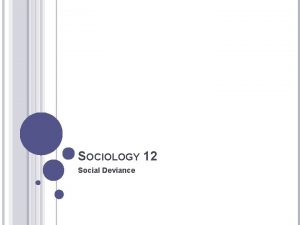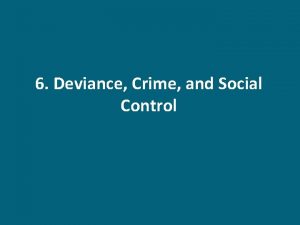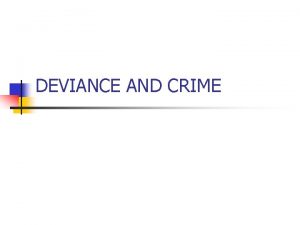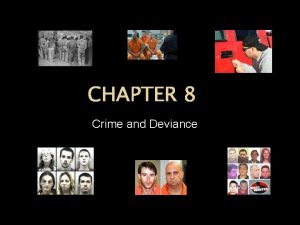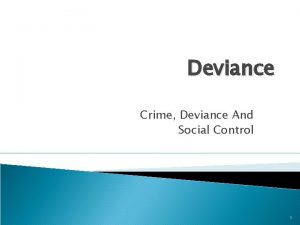SOCIOLOGY CRIME AND DEVIANCE REVISION GUIDE EXAM REVISION


































































- Slides: 66

SOCIOLOGY – CRIME AND DEVIANCE REVISION GUIDE: EXAM REVISION Scarlet

TOPIC 1: FUNCTIONALIST, STRAIN AND SUBCULTURAL THEORISTS EXAM REVISION

DURKHEIM’S FUNCTIONALIST THEORY: • Functionalists see society as based on a value consensus – it has members in society sharing shared values. • In order to achieve social solidarity, we need socialisation (teaching society's values) and social control (police, ensures people behave). The inevitability of crime: • Durkheim argues that crime is inevitable, and even beneficial for society • The right amount of crime will help prevent anomie/normlessness. The positive functions of crime: 1. Boundary maintenance: Crime creates a reaction from society, uniting them against the baddy! The punishment given to the criminal/deviant reinforces shared rules of society, showing the boundaries & this links to Cohen’s “folk Devils”, whereby the media dramatizes crime and deviance. 2. Adaptation and change: Durkheim says that all change that has happened has started with an act of defiance. People who have new ideas, values and ways of living must ignore some social norms and control. For example, persecution of religious visionaries. These new values may, however, lead to a good thing. E. g gay rights activists have brought on more acceptance, and more recently, the majority of MPs are backing gay marriage = Durkheim therefore argues that neither a high or low level of crime is wanted, just somewhere in the middle. Too much crime threatens bonds of society, and too little is repressive and prevents change Other functions of crime: • Davis supports the idea that crime can be positive. He argues that prostitution lets men release sexual frustration without threatening the nuclear family! • Linking to this is Polsky, who said that porn helps channel sexual desires, instead of something like adultery which harms the nuclear family • Cohen – crime and deviance acts as a warning that an institution is functioning badly, such as people skipping school • Erikson – says bodies such as the policy actually want to maintain crime due to its positive functions CRITICISMS: • Functionalists only focus on the positive outcomes of having crime in society – but ignore the serious aspect of these crimes such as rape and murder and its impact on society. • Functionalists also explain crime as if it was intended to be in society and it is needed to keep society going – but we could survive a society without crime. • Crime does not always promote social solidarity, it has the opposite effect bring people apart and causing isolation between groups – such as terrorist attacks etc.

MERTON’S STRAIN THEORY: • People engage in deviant behaviour when they are unable to achieve socially approved goals. • This strain creates frustration, creating pressures to be deviant in order to get what you want. Merton calls this “Strain to Anomie. CRITICISMS: • Merton combines structural factors (society’s unequal structure) and cultural factors (society emphasising success goals). • Merton takes official statistics at face value, in reality we learn it is deterministic and unrealistic. • Marxists argue that it ignores the power of the ruling class to make and enforce the laws in ways that criminalise the poor but not the rich. • It only accounts for utilitarian crimes and not crimes of violence or vandalism. The American Dream: • American culture emphasises success and achieving goals. • Crime and deviance is the result of strain between society’s goals, such as the American Dream, and finding the legitimate means of reaching that dream. • For example, poverty and inadequate schooling is a reason for work opportunities to be blocked, thus individuals turn to crime to provide. Deviant adaptations to strain – there are 5 different types of adaption to strain: • Conformity. Individuals see they have to work hard to get their dream, so achieve it legitimately • Innovation. Individuals see the need for money success so use illegitimate means to get there, such as fraud. • Ritualism. Give up on goals and get stuck in dead end jobs, e. g middle class office workers • Retreatism. Individuals reject legitimate and illegitimate means and become drop outs. E. g. psychotics, tramps, alcoholics, drug addicts. • Rebellion. Rebel against current means to get new ways of success. • Therefore, lower class and ethnic minorities are more likely to commit criminal acts because of their position in the social structure. • Merton explains the patterns shown in official statistics – Most crime is property crime, because American Society values material wealth so highly. • Lower class crimes are higher, because they have least opportunity to obtain wealth legitimately.

SUBCULTURAL STRAIN THEORIES: A. K COHEN - STATUS FRUSTRATION: • Cohen agrees with Merton that deviance is largely a working class phenomena • However, Cohen criticises Merton on two grounds: 1. Merton sees deviance as an individual response to strain, ignoring the fact that a hell of a lot of deviance is committed by groups. 2. Merton only focuses on utilitarian crime, ignoring things like vandalism. • Cohen focuses on deviance of working class boys. He argues they face anomie in a middle class school system. This links to cultural deprivation as they lack the skills to achieve. They are given a low status in society as they can’t achieve through education, so they turn to other boys in the same situation and form a subculture. Alternative status hierarchy: • Cohen says these subcultures are categorised by spite, hostility, and hate for everyone outside of the subculture. The subculture praises whatever mainstream society says is bad. E. g, they praise truancy. CRITICISM: • Unlike Merton, it offers explanations for non-utilitarian crimes. • However, like Merton, Cohen assumes working class start off, sharing the same success goals as middle class boys, which is not true. CLOWARD AND OHLIN - 3 SUBCULTURES: • They agree that working class youth are denied legitimate opportunities. However they say that different subcultures react differently, e. g economic crime, drug use etc, not JUST violence and vandalism like Cohen suggests. • They say these different responses occur because of lack of access to legitimate and illegitimate opportunity structures. 3 types of subcultures: • Criminal subculture – act as a sort of apprenticeship for youths to start a career in utilitarian crime. These subcultures only occur in areas where there already is a criminal hierarchy. • Conflict subculture – arise due to low social cohesion and a high population turnover. = high levels of disorganisation illegitimate opportunities are the only ones available. • Retreatist subculture – are the result of being unsuccessful in society and in conflict and criminal subcultures. They don’t succeed in society OR in a criminal subculture haha! They are double failures. CRITICISM: • They ignore the crimes of the wealthy and they over predict the crimes of the working class. • Miller argues working class subculture aims to achieve their own goals, not mainstream ones.

ESSAY PLANNING: Outline two reasons why functionalists see crime as inevitable – 4 marks. Firstly, functionalists believe crime is inevitable because not everyone is socialised appropriately, thus there will be individuals who are prone to becoming deviant. Secondly, crime is also inevitable because different groups develop their own subcultures, with distinctive norms and values, that differ with that of society. Applying material from item A, analyse two functions of deviance – 10 marks. Durkheim takes on the traditional functionalist perspective, in arguing society is based on a value consensus, whereby individuals can achieve social solidarity by having shared norms and values. Durkheim argues that crime and deviance is an important factor towards maintaining this solidarity. Thus, Durkheim argues crime has two important functions. The first function is boundary maintenance: this is the idea crime and deviance causes a reaction in society, that causes the majority to go against the criminal/deviant. In this, they are judged by either the court or prosecutors, this is not to ‘suffer’ the criminal/deviant, but prove the power and social solidarity of society, this shows social order and boundaries that should not be crossed in society and encourages others to stay away from crime. Interestingly, this correlates with Cohen’s study of the ‘Folk Devils’, whereby the media dramatized the true extent of the groups crimes, however, this brought communities together, as they tried to stop the ‘criminal’ movement. Supportingly, Davis agrees with Durkheim, he argues that crime can be vied positively, for example, the use of pornography can release men's sexual desires and frustration, without harming the nuclear family. Secondly, Durkheim argues crime and deviance also causes adaptation and change for those within society. Durkheim adds that all change starts with some form of rebellion or deviance – However, we need crime to push this type of change forward.

TOPIC 2: INTERACTIONISM AND LABELLING THEORY EXAM REVISION

THE SOCIAL CONSTRUCTION OF CRIME: CICOUREL – THE NEGOTIATION OF BECKER – LABELLING THEORISTS: • Labelling theory is an interactionist theory = instead of seeking to see the causes of crime, they identify why people are labelled criminal or deviant in the first place. • Becker says a deviant is someone who has been given a label, and the deviant behaviour is simply a result of this labelling. • Becker argues reasons for rules and laws are = moral entrepreneurs: these are people who lead a moral ‘crusade’ to change the law. • However this has 2 effects: 1. The creation of a new group of ‘outsiders’ or ‘outlaws’ = deviants who break the new rule. 2. The creation or expansion of social control – the police, probation officers etc. To enforce the rule and impose labels on offenders. • Platt (1969) argues ‘juvenile delinquency’ was originally created as a result of campaigns by Victorian moral entrepreneurs – created separate category for youth offenders where they had their own court, and laws applied to them. (Youth behaviour was only an offence because of their age) – such as truancy and sexual promiscuity. Who gets labelled: • Not everyone who is deviant gets punished – depends on interactions with police or courts, their appearance or their offence. E. g. recently 2012 found that police much more likely to stop and search black males. • Pilliavin and Briar found that police decisions to arrest youth were greatly based on physical cues. JUSTICE: • Used participant Observation and non participant observation and found that officers typifications and stereotypes led them to look for certain types of people. • Led to a class bias, with working classes fitting their typifications most closely. • They patrolled more working class areas and labelled more working classes as deviant. • This may be why today the working class are over represented in crime stats. = justice negotiable as middle class less likely to be charged for the same offence. • Cicourel undermines official statistics – they do not give us a valid picture of patterns of crime and cannot be used as a resource. • We should treat official statistics as a topic = we cannot take crime statistics at face value.

THE SOCIAL CONSTRUCTION OF CRIME STATISTIC: • Interactionists see official crime statistics as socially constructed = invalid and unreliable. • Each stage of criminal justice system – agents of social control, such as police, make decisions on whether to go further = depending on your age, ethnicity etc, depends on their reaction. • Results thus produced by criminal justice system just tells us about activities of the police = rather than the amounts of crime in society and who produces them. • The dark figure of crime: Difference between official statistics and real rate of crime is the dark figure – as it is unseen. • Alternative statistics: Some sociologists prefer victim surveys where the victims can identify their experience – however there are weaknesses = they could lie or exaggerate their experience.

THE SOCIAL CONSTRUCTION OF CRIME: PRIMARY AND SECONDARY DEVIANCE: • Lemert (1951) distinguished between primary and secondary deviance. Argues primary deviance goes mostly uncaught, such as dodging a fair. • A primary act is not necessary planned or a normal part of the person’s life so they can just say “hey, that was just ONE blip”, and is does not result in a label. • Master status: Secondary deviance is the result of societal reaction. Secondary deviance is labelled, and is the result of labelling of society. Once individuals are labelled – humiliated and shunned from society they accept the label attached to them – it becomes their master status = in the eyes of the world, they are no longer a man, or father or brother, but a criminal = this can cause provoke a crisis for an individuals self-concept or sense of identity. • Deviant career: Secondary deviance = provoke hostile reactions from society – those labelled are treated negatively. The labelled may turn to deviant subcultures because they may struggle with acceptance and finding work – reproduces deviant career. • Jock Young (1971) uses concepts of secondary deviance and deviant career in his study of hippy marijuana user, example of primary deviance = control culture (police) labelled hippies as ‘outsiders’ and this made them go into deviant subcultures as they felt left out in society. DEVIANCE AMPLIFICATION SPIRAL: • This meaning, the attempt to control deviance = leads to more deviance. • Labelling theorists applied theory of deviance amplification spiral to Cohen’s study of Folk devils. • Press exaggeration and distorted reporting of the events began a moral panic – growing public concern = moral entrepreneurs will call for ‘crackdown’. • Police responded by arresting more youth – whilst court gave out harder penalties. • This showed deviance amplification spiral = the more they tried to control it, the more they became deviant, as society saw them as ‘outsiders’. • Folk devils vs the dark figure: The dark figure are hidden and underrepresented and unrecorded – such as crimes of the powerful. On the other hand = folk devils are overrepresented and exaggerated in the media.

LABELLING AND CRIMINAL JUSTICE POLICY: • Studies have shown increases in the attempt to control and punish young offenders can have the opposite effect. • Triplett (2000) in USA, youth are increasingly seen as evil and police are less tolerant of their minor deviance. • The criminal justice system can re-label an act, such as becoming less tolerance of minor deviance by making things like truancy seem a more major offence. • Thus, a way we can decrease crime is by having fewer laws associated with it = by decriminalising soft drugs, we can reduce the number of people with criminal convictions. • We should also avoid labelling criminals as evil and bad, and naming and shaming them as this makes them outsiders in society. REINTEGRATIVE SHAMING: • Braithwaite (1989) two types of shaming: • Disintegrative shaming: where the crime and the criminal are labelled bad or evil – pushes deviant away from society. • Reintegrative shaming: labels the crime not the actor – allows them to join society. • Braithwaite sees a positive role of labelling as it disintegrative labelling labels the criminal and the crime as bad, but reintegrated labelling labels the criminal act, but not the actor (criminal). CRITICISM: • Deterministic • Emphasises negative effects of labelling. • Assumes all offenders are passive victims of labelling • Doesn’t explain why people commit primary crime • Marxist say it ignores how capitalism acts in labelling • Suggests deviance would not happen if labelling didn’t happen.

SUICIDE: MENTAL ILLNESS AND SUICIDE – THE SOCIOLOGY OF DEVIANCE: • Interactionists are interested in not just crime – but deviant behaviour, which is seen as suicide and mental illness. • Example: Durkheim (1897) studied Suicide – trying to show sociology is a science. However, Interpretivists reject this because his approach relied on official statistics and they reject this = interpretivists argue we should study meaning of individuals behaviour. Douglas – the meaning of suicide: • Douglass takes an interactionists approach of suicide = he is critical of the use of official statistics as he believes they are unreliable and untrustworthy. • Both crime and suicide statistics are socially constructed. • For example: whether a death is marked as a suicide depends on the coroner, relatives and friends responses. • Relatives may feel guilty about a death and may state death wasn’t suicide, instead perhaps a homicide. Similarly, coroner with strong religious views, may not want to bring in a suicide case. • Statistics therefore tell us nothing about the meanings behind individuals actions to commit suicide = we must thus use qualitative methods to analyse suicides such as = suicide notes (personal documents) or unstructured interviews – with family and friends of the dead. • This will allow us to know the true meaning behind the deaths. Atkinson – coroner’s common-sense knowledge: • Atkinson (1978) agree that official statistics are influenced by coroners approach – he argues it is impossible to know the meanings for people’s deaths. • Atkinson focuses on taken for granted aspects of suicide = assumptions coroners make when reaching their conclusion = Atkinson argues there are “typical suicides” such as hanging and over-dosing – a coroner stated that if the dead took 10 sleeping pills, it was a suicide, it is thus clear, coroner’s report was based on assumption. Criticism: • However, if we apply Atkinson’s theory to himself, it means his theory is simply an interpretation, rather than a real fact.

MENTAL ILLNESS: • As with crime and suicide – interpretivists reject official statistics on mental illness, because they see it as socially constructed. • Official statistics are simply a record of what doctors and psychiatrists label their patients – crime, suicide and mental illness are artefacts (things made by humans) because they are not objective social facts. Paranoia as self-fulfilling prophecy: • Interactionists are interested in how a person comes to be labelled as mentally ill – Lemert’s (1962) study of paranoia; (Lemert notes that some individuals don’t fit easily into group- as a result of this primary deviance, they are labelled odd, and are excluded from society). • Lemert argues a negative response to this is the beginning of a secondary deviance = which gives further reason for them to be excluded in society – those who labelled them will think of ways of dealing with this ‘difficult’ person. • This will cause him to confirm his thoughts that people are against him = support the labellers fears of mental health – may lead to psychiatric intervention, this will result in them being officially labelled “mentally ill” and perhaps sent to a mental institution. • As a result, the label “mentally ill” will become his master status = he will forget any previous identities, such as being a father, son or employee. • An example comes from Rosenhan’s (1973) ‘pseudo-patients’ experiment – where a number of researchers admitted themselves in, stating they were hearing voices – they became diagnosed “schizophrenic” and this became their master status, even though they were acting normal. Institutionalisation: • Goffman’s (1961) study of ‘Asylums’ shows the possible effects of being admitted into a total institution – such as a psychiatric hospital. • On admission, inmate undergo a ‘mortification of the self’ in which their old identity is symbolically killed and replaced with a new one = an ‘inmate’, this is done by many degradation rituals, such as the confiscation of personal items and memories. • Goffman showed that some inmates accepted their institutionalisation – it became their master status, they did not want to be released from the hospital. Evaluation of labelling theory: • It is deterministic, it assumes once labelled, a deviant career is inevitable. • It tends to focus on less serious crimes, such as drug use. • It romanticises the idea of negative labels having bad effects on criminals, giving them victim status – realists argue they ignore the real victim of crimes.

EXAM PLANNING: Outline two criticisms of the labelling theory – 4 marks. The labelling theory is argues to be to deterministic, in believing once an individual is labelled deviant or criminal, it becomes their master status, this is not the case all the time – some individuals do not accept the label. Secondly, it romanticises the idea of negative labels, allowing labelled criminals and deviants, to have a victim status – Realists argues we should remember the true victims are those affected by crime. Applying material from item A, analyse two effects of the labelling process on individuals and groups – 10 marks. Through item A, we learn that the labelling process has a negative impact on those it is applied to. Lemert distinguishes between primary and secondary deviance, in doing so, he argues our primary deviance, is typically out of the norm, to do in our daily routine, for example, dodging a pay fair. Individuals may not see themselves as criminal or deviant, because that was their one off. However, secondary deviance occurs from society’s own reaction of a crime or behaviour. This is when an individual is thus labelled and shunned from society for the act they have committed – this thus becomes their master status, depending on the act, they may become labelled “thief, murderer or rapist”, in the eyes of the world, they will not be seen as a father, brother or employee, but simply a criminal. Once this identity is accepted and inherited, it leads to a deviant career. A deviant career whereby the labelled receive hostile reactions from their previous community, they may be judged and ignored, and may find it difficult to find a job, therefore they are restricted from any form of work and this causes further problems for the labelled, as it means they will experience some frustration and anger at society. Unfortunately, this will result in them being pushed into a deviant subculture – a group of individuals who have been excluded from society. For example, Jock Young used deviant subculture and deviant career in his study of the ‘marijuana hippies’ that were under the control culture with the police. Eventually, because they were taking drugs, the police and the rest of society deemed them deviant and segregated the from mainstream society. However, a weakness of this labelling process is the fact it assumes once labelled, a self-fulfilling prophecy takes place and this is not always the case. Secondly, another effect of the labelling process is found in interactionist, Lemert’s study of paranoia, in mental illness. He indicated an explanation of the effects of labelling should be understood. In his study, he stated, some individuals generally do not fit in well with others of mainstream society. Thus, they are labelled odd or ‘different’ by those in power. This creates a primary deviance, that the labelled are somewhat aware of. However, this spurts a negative response which causes a secondary deviance, which gives the labelled further reason to be excluded from society, and those in power that have labelled the individual now think of ways to ‘deal’ with them. This will cause the labelled to feel as if society is truly against them, they may move themselves into a deviant subculture, with the means of rejecting the attitudes of society. Lemert argues those who have labelled this individual may attach “paranoia” to them, and may even send them to a mental institution to confirm that they must be truly “mentally ill”. Lemert argues this shows the effects of labelling those who perhaps do not ned the label. For example, Rosenhan’s study (1973) of the ‘pseudo-patient’ was a result of false labelling, whereby researchers admitted themselves to hearing voices and were given the label “mentally ill”, this became their master status, whilst they were in there. This suggests that labelling carries a greater and damaging effect once applied. However, realists would argue labelling theorists give criminals the victim status, whilst ignoring those who have truly been the victims.

TOPIC 3: CLASS, POWER AND CRIME EXAM REVISION

EXPLANATIONS OF CLASS DIFFERENCES IN CRIME: • Official statistics around the world show class differences in rates Cohen see’s w/c youths as culturally deprived, they have not been of offending – working class more likely to commit crime than socialised into mainstream m/c culture. middle class = theories in this topic examine the patterns. • W/c failure to achieve leads to status frustration – delinquent Functionalism: subculture they join is a solution to their status frustration. • Functionalism sees the law as a reflection of society’s shared • Cloward and Ohlin build on Merton and Cohen = Cloward & Ohlin values – crime is the product of inadequate socialisation into these identify why crimes are more evident in w/c –> Criminal values. Not everyone is equally socialised into society’s shared subculture: stable w/c community with prevailing criminal culture – in modern society, different groups and classes develop professions. Conflict subculture: gang violence and turf wars with their own separate subcultures. high population. Retreatism subculture: a ‘drop out’ drug subculture of those who fail in legitimate and illegitimate • For example = Walter B Miller, argues the w/c has developed an opportunity structures. independent subculture, with its distinctive norms and values – contrasts with mainstream society’s values. Labelling theory: • W/c contrast with mainstream society’s values = because they • They reject the view that official statistics are a useful resource for conform to subcultural norms, such as toughness and pursuit of sociologists that give a valid picture of which class commits most excitement – can lead to conflict with the law. crime & they focus on how w/c people become labelled in the first place = they consider the attitudes of social control and their Strain theory: typifications of the ‘ideal criminal’. • They argues people engage in deviant behaviour when their • Labelling theorists seen as problem makers because they reject opportunities are blocked to success – for example, Merton argues official statistics. the American societies structure denies w/c people the opportunity to achieve. Marxists theory: • W/c likely to be denied legitimate opportunities to achieve – e. g • Marxists agree with labelling theorists that the law is enforced through educational achievement or a good job = more likely to wrongly against the w/c and thus official statistics cannot be used. seek illegitimate goals, Merton calls this innovation. • However, they criticise labelling theorists for ignoring wider • W/c may become involved in theft, fraud or drug dealing = explains structural problems such as capitalism. why w/c commits utilitarian crimes. Subcultural theories: • W/c people deprived of legitimate means of success = for example,

MARXISM, CLASS AND CRIME: CRIMINOGENIC CAPITALISM: • Crime is inevitable because capitalism by its very nature causes crime. It is based on the exploitation of the working class and this may give rise to crime: • Poverty may mean that crime is the only way the working class can survive. • Crime may be the only way they can obtain the consumer goods they are encouraged by advertising to buy, resulting in utilitarian crimes such as theft. • Alienation and lack of control over their lives may lead to frustration and aggression, resulting in non-utilitarian crimes such as violence and vandalism. • Crime is not confined to the working class. Capitalism encourages capitalists to commit white-collar and corporate crimes – because it is competitive etc. • Gordon (1976): Crime is a rational response to the capitalist system and is found in all social classes. THE STATE AND LAW MAKING: • Law making and law enforcement only serve the interests of the capitalist class. • Chambliss (1975): laws to protect private property are the cornerstone of the capitalist economy. • The ruling class also have the power to prevent the introduction of laws that would threaten their interests. • Selective enforcement: Snider (1993): The capitalist state is reluctant to pass laws that regulate the activities of businesses or threaten their profitability. Powerless groups such as the working class and ethnic minorities are criminalized and the police and courts tend to ignore the crimes of the powerful.

IDEOLOGICAL FUNCTIONS OF CRIME AND LAW: • The law, crime and criminals also perform an ideological function for capitalism – laws are occasionally passed that seem to • Pearce – caring face of capitalism - laws often benefit the ruling class when LOOKING like they help the working class, such as safety laws which actually keep workers healthy to keep working for low wages = makes capitalists look caring. • The state enforces the laws selectively – crime appears to be largely a working class phenomenon (divides working class by encouraging workers to blame criminals rather than capitalism). • The media and criminologists portray criminals as disturbed individuals = when capitalism makes them criminals. Evaluation of Marxism: • It largely ignores the relationship between crime and nonclass inequalities such as ethnicity and gender. • It is too deterministic and over-predicts the amount of crime of the w/c – not all poor people commit crimes, despite their needs. • The criminal justice system does sometimes act against the capitalist class, for example, the court prosecuting businesses.

NEO-MARXISM – CRITICAL CRIMINOLOGY: • Neo-Marxists are influenced by Marxism – but combine ideas from labelling of crime and deviance that would change the way it is perceived. theory = most important critical criminologists are Taylor, Paul Walton and • Ideas from both traditional Marxism (unequal distribution of wealth) and Jock Young (1973) interactionism/labelling (meaning of deviant act and effects of a deviant label) • Taylor et al agrees with Marxists stating: 1. Capitalist society is based on exploitation and class conflict and inequalities • The theory of deviance needs to unite 6 aspects: between rich and the poor. 1. Wider origins of a deviant act 2. The state enforces law benefiting the ruling class. 2. Immediate origins of a deviant act 3. Capitalism should be replaced by a classless society – there should be 3. The act itself communism. • However, Taylor et al also differ from many other Marxists – they call themselves critical criminology. Anti-determinism: • Taylor et al argues Marxism is deterministic in believing workers commit crime because of economic necessity. 4. Immediate origins of social reaction 5. Wider origins of social reaction 6. The effects of labelling • Taylor says that these 6 aspects are interrelated and make the one unified theory work. • They reject theories that use external factors such as anomie, subcultures or Evaluation: labelling as well as biological or psychological factors. • Instead Taylor et al takes a voluntaristic view – we have free will to choose • Feminists say that its gender blind, ignoring female crime how we act – the opposite to determinism. • Left Realists say it romanticises working class crimes, making it look like Robin Hood heroes • They see crime as a meaningful action that is chosen by the actor committing the crime. • They ignore how serious working class crime actually is • They believe crime has a political motive, like taking from the rich and giving • Without capitalism, society would have a lack of structure and would crumble. to the poor. • Criminals are not passive puppets whose actions are shaped by capitalism. A fully social theory of deviance: • Taylor et al aim to create a “fully social theory of deviance” – an explanation

CRIMES OF THE POWERFUL: WHITE COLLAR AND COPORATE CRIME: THE SCALE AND TYPES OF COPORATE CRIME: • Edwin Sutherland devised the term ‘white collar crime’ in 1949 = it means a crime is committed by a person of high status, in course of his occupation. • White collar crimes and corporate crimes do far more harm than street crimes. • Sutherland wants to show m/c workers commit crimes too, he shows 2 types of crimes: • Corporate crimes have wide range of acts and omissions, including the following: 1. Financial crimes: tax evasion, bribery, money laundering and illegal accounting. Victims include other companies, tax payers and governments. 1. Occupational crime: committed by employees simply for their own gain 2. Crimes against consumers: false labelling and selling unfit goods. 3. Crimes against employees: sexual or racial discrimination. Health and safety for employees. Palmer stated the occupational diseases cause 50, 000 deaths a year in the UK. 4. Crimes against the environment: illegal pollution of air, water and land, such as toxic waste dumping. 5. State-corporate crime: crimes committed when the government and businesses work together to pursue their own goals – Rolls Royce debt and money laundering. 2. Corporate crime: committed by employees for their organisation, in pursuit of its goal, e. g deliberately miss – selling products to increase company profit. • Many harms of the powerful do not break the law = for example, breaking codes of practice – thus to overcome this problem, Pearce and Tombs (2003) state corporate crime is an illegal act, deliberately done to help a business succeed. • Tombs (2013) argues it depends on who has the power to define an act – powerful corporations can influence the law so their actions are not criminalised. • Tombs (2013) argues corporate crime has big costs, physical (deaths, injuries and illnesses), environmental (pollution) and economic (consumers, workers, taxpayers and government). The abuse of trust: • High status professionals occupy positions of trust and respectability – Carrabine et al (2014) we entrust our finances, our health and our security and personal health with them – however their position and status give them opportunity to abuse this trust. • Accountants and lawyers can be employed by criminal organisations to launder criminal funds into legitimate businesses – they can act corruptly by inflating fees, committed forgery, illegally diverting clients’ money. • Crime of this kind violates the trust that society places in professionals. Sutherland argues this makes corporate crime.

THE INVISIBILITY OF CORPORATE CRIME: EXPLANATIONS OF CORPORATE CRIME: • The crimes of the powerful are invisible– even when they are visible, they are not seen as real, for many reasons: Strain theory: • Box (1983) uses Merton's innovation concept for corporate crime = argues that if a company cannot achieve its goal of maximising profit by legal means, it will employ illegal ones instead. • When businesses are in bad position they are tempted to break the law. Differential association: • Sutherland (1949) sees crime as behaviour learned from others in a social context – if a company’s culture justifies committing crimes to achieve corporate goals, employees will accept this and commit crimes. • The culture of business may also favour and promote competitive, aggressive personality types – who are willing to achieve success through crimes. Labelling theory: • Whether an act counts as a crime depends on whether it has been labelled a crime. • Typically w/c more likely to have their actions labelled criminal – whilst m/c will have there’s labelled ‘youthful high’. • Businesses have the ability to avoid labelling = for example, hiring expert lawyers that will remove them from crime related activities. Marxism theory: Capitalism has successfully created what Box calls a ‘mystification’ = spread the ideology that corporate crime is less widespread or harmful than working class crime. 1. The media: give very limited media coverage of corporate crime – less people are aware of it, less like to understand it. 2. Lack of political will: government / politicians focus on street crime. Home office use crime surveys to tackle ordinary crime, but not corporate. 3. The crimes are often complex: law enforcers are often understaffed, under-resourced and lacking technical expertise to investigate effectively. 4. De-labelling: for corporate crimes, it is seen as civil not criminal, they are often given fines rather than sentences. 5. Under-reporting: victims are unaware of how to report a crime against an organisation, because it is not just done by one individual, but a company. 6. However, since 2008, corporate crime has been made more visible.

EVALUATION: • Both strain theory and Marxism overpredict the extent of business crimes Nelken (2012) argues it is unrealistic to assume all businesses would commit crimes if it wasn’t illegal. • Braithwaite argues law abiding can be more profitable than law breaking.

EXAM PLANNING: Outline three reasons why white collar crime and corporate crime may have low rates of prosecution – 6 marks. One reason for why white collar crime and corporate crime may have low prosecution rate, is because of the way in which corporate crime is limited in its media coverage. Society thus doesn’t notice when it occurs because other exaggerated crimes that are being reported. Secondly, lack of political will, whereby the government use crime surveys to focus on street crime, and ignore corporate crime – which suggests to the public, it must be low. Lastly, the police lack the resources and knowledge to tackle something as complex as corporate crime, and thus, they tend to focus on much more public acts like fighting, theft and vandalism. Applying material from item A, analyse two ways in which Marxists see class and crime as related – 10 marks. Item A clearly indicates, one idea Marxists hold, is that capitalism is an inevitable cause of crime. They argue that the nature of capitalism is to exploit the working class and compliment the success of the ruling. In exploiting the working class, they are depriving them from an efficient income, and thus, they become materially and economically lacking, unlike their employers, who can afford what is being sold in the latest market. This encourages the working class to be involved in financial crimes, such as theft, fraud or drug dealing, as it is the only illegitimate way of receiving large amounts of money. However, because the capitalist system indoctrinates its workers with alienation and a lack of control, w/c workers begin to feel anger and frustration at the system, and thus express themselves by committing non-utilitarian crimes like vandalism and violence. Although Marxists acknowledge working class crimes, they also acknowledge those of the middle class. They argue capitalism encourages a ‘dog-eat-dog’ mentally, whereby it is competitive to achieve success; this encourages corporate and white collar crimes. David Gordon (1976) argues crime is a rational response to a capitalist society and is found in both the working class and middle class. However, a profound weakness of this theory is that it ignores wider relationships between crime and non-class equalities, like gender and ethnicity. Sutherland originally devised the term ‘white collar crimes’, meaning a crime committed by a person of a respected or high status. For Marxists, corporate crimes are a result of the normal functioning of capitalism. In this view, because capitalism’s goal is to achieve success and maximise profit, it is inevitable for it to cause harm, such as deaths and injuries, among its consumers and employee’s. Marxist, Box argues capitalism has created a ‘mystification’, this meaning, it has spread an ideology that corporate crime is less widespread or harmful than working class crime. Capitalism’s control over the state means that it is able avoid laws that will conflict with their interests. Although some corporate crimes are dealt with, this is seen as the tip of the ice burg. Box also argues that corporations are criminogenic because once their legit means to profit are blocked, they will resort to illegal means of maximising profit – this explains why middle class crime occurs. However, both the strain theory and Marxism seem to over-predict the amount of business crimes that take place. Nelken (2012) argues it is unrealistic for these perspectives to assume there is so much crime in the business place, as not every company is motivated to do so.

TOPIC 4: REALIST THEORIES OF CRIME EXAM REVISION

RIGHT REALISM: THE CAUSE OF CRIME: Criticisms of the right realist explanation: • • • It ignores wider structural causes such as poverty. It overstates offenders rationality and how much they pre plan their actions of committing crimes, this is not the reality. It overstates biological factors causing crime – no evidence supporting their argument. • They reject the ideas put forward from Marxists and others. They reject that structural or economic factors such as poverty and inequality = for causes of crime. • They point out that the old tend to be poor, but have a low crime rate. Biological differences: • Wilson and Herrnstein (1985) have a biological theory of criminal behaviour – they argue crime is caused by biological and social factors. • Biological differences in people make some people inherently more likely to commit crimes. • For example, being aggressive, extroversion, risk taking and have a low impulse control = means they are more likely to offend. • Herrnstein and Murray (1994) argue the main cause of crime is low intelligence – they see this as biologically determined. Socialisation and the underclass: • Biology increases the chance of one offending = adequate socialisation decreases it. • Socialisation involves learning self-control and internalising moral values of right and wrong = the best agency of socialisation is the nuclear family. • Charles Murray (1990) argues that the crime rate is increasing because of parent inadequate socialisation – caused by welfare dependency in UK & America. • Murray argues the generous welfare state, causing increase in lone parent families, and decrease in nuclear family, as women can depend on the system, and can look after children on their own = Murray argues single mothers are inadequate socialisation agents. • Absent fathers mean that boys lack paternal discipline or male role models = turn to deviant subcultures. Rational choice theory: • Individuals have free choice and power of reason = Ron Clarke (1980) argues the decision to commit a crime is a rational choice form an individual. • If the reward of the crime overweighs the cost of the crime = individuals more likely to commit the act. • The perceived cost of crime has decreased, so individuals more likely to commit crimes. • Felson (2002) argues for crime to occur, there must be a motivated offender, a suitable target and an absence of a ‘capable guardian’ (police).

TACKLING CRIME: • Right realists argue socialisation and biological factors cannot easily be changed, therefore there should be more practical factors – we should focus on punishment and means of control. • Crime prevention policies should reduce the rewards of crime and increase the cost – for example, target hardening = greater use of prison & quick punishment. • Zero tolerance: Wilson and Kelling’s (1982) article ‘broken windows’ shows we should uphold an orderly neighbourhood – any vandalism, theft or graffiti = should be dealt with immediately. • Wilson and Kelling’s emphasise a zero tolerance policy = undesirable acts such as drunkenness, prostitution and begging, should be removed immediately. • Police should control the streets, so law abiding citizens can feel safe – supporters of the zero tolerance said it succeeded in new York. Zero tolerance: an urban myth: • Zero tolerance introduced in new York, in 1994 = widely respected for reducing crime – however, Jock Young (2011) argues it’s success was a myth by police and politicians to take credit to decline of crime. • Crime had been decreasing prior to the introduction of zero tolerance = 9 years before the policy was introduced. • Young argues the police need arrests to justify their existence – shortage of serious crimes meant the police has to create more ‘deviance’ = they arrested people for minor deviant crimes. • Police would re-label acts to seem much more serious – in reality, police and politicians did nothing, they lied they were cracking down on crime. • Success of zero tolerance was just a product of the police and governments way of coping with declining crime. Criticism: • It gives the police the right to arrest anyone, include ethnic minorities.

TAKING CRIME SERIOUSLY: LEFT REALISIM: • Argue crime is a real problem – that affects disadvantaged groups. • They accuse other sociologists of not taking crime seriously: 1. Marxists: concentrated on crimes of the powerful and capitalism. 2. Neo-Marxists: romanticise working class crime, ‘robin hood’ theory. 3. Labelling theorists: portray w/c criminals as the victim. • First part of left realism is to recognise increase in crime. • Aetiological crisis: Meaning a crisis in explanation - from 1950’s on there was real increase in w/c crime = however, labelling theorists and critical criminology reject this and argue there was over-reporting of crime. • Left realist argue there was an increase in real crime, more people were becoming victims. • Left realists use victim survey’s and British crime survey for evidence. • Left realists argue disadvantage groups have greater risk of being victims to crime – such as theft, violence and street crime. • Example, fear of attack, may stop women from going out at night – women are less likely to report crimes as police are reluctant to deal with them – example, domestic violence, rape or racist attack.

THE CAUSE OF CRIME: • Second part of left realism is explain the rise in crime from 1950’s. • Lea and Young (1984) identify 3 related causes of crime: Relative deprivation: • Lea and young that relative deprivation contributes to increase in crime – however, it is not the full explanation, as in 1930’s poverty was high, yet crime was low. • Left realists refer to Runciman’s (1966) concept of relative deprivation = when someone feels deprived in comparison with others – results in crime, as individuals may wan to commit a crime to achieve what they lack. • Lea & young argue today’s society is prosperous, yet crime-ridden = people are better off, however, some are in relative deprivation because of media and advertising = ‘keeping up with the joneses’. • Young (1999) argue that the lethal combination of individualism and relative deprivation has led to crime. Individualism = pursuit of selfinterest, at the expense of others & Individualism = creates an increased anti-social behaviour and aggression and then crime. Subculture: • Left realists argue a subculture is a group’s collective solution to the problem of relative deprivation. • However, different groups produce different subcultural solutions to the problem of relative deprivation – some turn to crime, others turn to religion that gives them spiritual support and Weber’s theodicy of disprivilege. • Religious and criminal subcultures, bring somewhat comfort for those apart of the groups = they can either accept their relative deprivation (religion) or take advantage of it (crime). Marginalisation: • Marginalised groups lack clear goals and organisations to represent their interests = groups such as workers, have the trade union representing their views, so they do not need to result to violence to have their financial issues solved. • However, non-working groups (unemployed youth) are marginalised – they have no organisation to represent them and no clear goals, just a sense of resentment & frustration. • By being marginalised – they turn to crime as a result of frustration.

LATE MODERITY, EXCLUSION AND CRIME: • Young (2002) argues that we are living in a period of late modernity – generalised throughout society, rather than being confined to those at where instability, insecurity and exclusion = make crime worse. the bottom – everyone desires the better aspects of life. There is a ‘relative deprivation downwards’ where the middle class, who work • Argues the ‘Golden age of modern society was in the 1950’s and 60’s = hard for their income, are angered at the underclass for using benefits period of stability, security and social inclusion = there was full to buy their materialistic desires. employment, good welfare state, low divorce rates and strong communities. • Young concludes that reactions to crime are changing, there is a thin crime between acceptable and unacceptable behaviour = thus there is • Since the 1970’s, insecurity and exclusion has increased = dea weakness in control – this makes the public more intolerant as they industrialisation and loss of unskilled jobs have increased employment demand stricter penalties. – especially for young people and ethnic minorities. The falling crime rate: • More jobs are low paid and short term = this has destabilised the family • Young addresses a ‘second aetiological crisis’ / crisis of explanation = & community life. since 1990’s crime has fallen, this is a problem for realist who argue • New right government policies have held back welfare spending. that crime is a major threat (Young argues crime is ‘seen’ as a major threat, in reality, it is not. • Greater inequality between rich and the poor has spread to the free market = encourages individualism and relative deprivation. The rising anti-social behaviour rate: • Young argues growing contrast between cultural inclusion and • Since 1990’s government have tried to control crime, they introduced economic exclusion – as a source of relative deprivation: ASBO’s, which have 3 several key features: 1. Media-saturated late modern society promotes cultural inclusion – 1. Blurring the boundaries of crime – breaching ASBO becomes a everyone, including the poor have access to media and consumer crime in its-self. advertising. 2. Subjective definitions – anti-social behaviour has no objective 2. Greater emphasis on leisure, personal consumption and immediate meaning. gratification – leading to higher expectations for the good life. 3. Flexibility – ASBO’s have been used against people depending on 3. Despite ideology of meritocracy = the poor are denied opportunities what they are wearing. to gain access to wealthy life. • Young argues that society creates crime by setting cultural goals (material wealth) while denying people the opportunity to achieve them legitimately (getting decent jobs). • Another trend in late modernity is for relative deprivation to become

TACKLING CRIME: • Lea and Young (1986) argue the police spend little time investigating crime – they should be more involved in their police style. • Military policing – police depend on the public for information about crimes. However, the police are loosing public support and cannot identify information about situations. They thus use military policing = like SWAT teams and random stop and searches. • Also say crime tackling cannot be left to the police alone – multi agency approach – local council, social services, housing departments and school/ leisure services need to help out against crime. Tackling the structural causes: • Tackling structural causes – causes of crime lie in unequal structure of society, so structural changes are needed to tackle crime. E. g. deal with inequality of opportunity, such as in education, to tackle crime – e. g aim higher, EMA etc. Left realism and government policy: • Government Policy – tough on crime, tough on the causes of crime (New Labour) E. g new labour tough on hate crimes like sexual abuse, as well as introducing ASBO’s. However ASBOs are being scrapped. • New Labours New Deal – helping unemployed youth and anti-truancy policies. Criticisms: • Accepts that street crime is committed by the poor • Rely on quantitative data from victim surveys and so cannot see true motives • Use of subcultural theory means that they believe that crime only happens when the value consensus breaks down • Relative deprivation does not fully explain crime as not everyone who is relatively deprived commits crime. For example, a teacher is relatively deprived to a doctor, but does not necessarily commit crime.

EXAM PLANNING: Outline two realists solutions to the problem of crime – 4 marks. One solution would come from Left realist, Kelling, who makes reference to ‘zero tolerance’, introduced in 1994, New York, it hardened police activity on criminals, which essentially ‘cracked down’ on small-scale crimes, to big. Another solution would come from right realists, Lea and Young (1986) argue that policing tactics should change, they should spend more time investigating crimes and improve their relationship with the local community. Applying material from item A, analyse two explanations of the causes of crime put forward by right realists – 10 marks.

TOPIC 6: ETHNICITY, CRIME AND JUSTICE EXAM REVISION

• • ETHNICITY AND CRIMINALISATION: Official statistics show blacks and Asians are overrepresented statistic – black people make 3% of population, but 13. 1% in prisons, Asians make 6. 5% of population, but 7. 7% make up prison statistic = White people are underrepresented. Official statistics do not tell us what ethnic group is likely to commit a particular crime, they simply state who is involved in the crime. ALTERNATIVE SOURCES OF STATISTICS: • 2 types of statistics – victim survey’s and self-report studies. Victim surveys: • Victim survey’s ask individuals what crimes they have experienced, in the last 12 months – you can gain information, of ethnicity and gender of criminal, it also states the type of crime being committed. • Victim survey’s show crimes are ‘intra-ethnic’ = takes place within an ethnic group, rather than between groups. • However, there are problems with this method: 1. They rely on individuals memory, which varies because crime could have happened long ago. 2. They only cover personal crimes, which make up 5% of statistics. 3. They exclude white collar crimes. • Victim surveys only give us limited information. ETHNICITY, RACISM AND THE CRIMINAL JUSTICE SYSTEM: • Self report studies ask individuals to report their own crimes – based on sample of 2, 500 Graham and Bowling found (43%) blacks, (44%) whites, (30%) Indians, (28%) Pakistani’s, (13%) Bangladeshis. • Statistics show that whites and mixed groups were most likely to say they had committed an offence. • The Home Office favour official statistics because they provide ‘remarkable’ findings, for example, Sharp and Budd found that 27% of mixed raced men stated they had an intake of cannabis. • Self-report studies challenge the stereotypes of black people as being more likely to whites to offend. • However, self-report studies have limitations, they are inconsistent – for example, while official statistics and victim surveys point to the likelihood of black people more likely to commit crimes, self report studies contrast this.

ETHNICITY, RACISM AND THE CRIMINAL JUSTICE SYSTEM: • There are ethnic differences in the stages of the criminal justice process. their stereotypes of individuals to discriminate. • Demographic factors – ethnic minorities are more likely to be stopped and searched, such as the young, unemployed, manual workers. These groups are • Phillips and Bowling (2012) note, since 1970’s there have been many likely to be searched regardless of their ethnicity, however, ethnic minorities allegations of oppressive policing of ethnic minorities, this includes, mass stop tend to fit into this category. and searches, armed raids, police violence and deaths and excessive surveillance. Arrests and cautions: Policing: Stop and search: • In 2015/14, blacks 3 times more likely to be arrested than whites – blacks and Asians are less likely to receive a caution, whilst whites do. Once reason for • Minority ethnic groups are more likely to be stopped and searched by the this is because members of minority ethnic groups are more likely to deny the police – police can use this power if they have any suspicions of individuals. offence, and ask for legal advice because they do not trust the police. Compared with white people, black people are 7 times more likely to be stopped and searched – Asians are twice as likely. Prosecution and trial: • Only small percentage of stop and search ends in arrest – under the terrorism • CPS (Crown prosecution service), is responsible for cases brought by the act 2000, police can stop and search any persons, vehicle even if they are not police – they decide whether an individual should be prosecuted. Philips and suspicious. Bowling's found that ethnic minority cases brought to CPS, are less likely to be dropped because they tend to be weak cases based on police racism. • Philips and Bowling (2007) argue members of these communities, are more likely to be stopped and searched, they are also ‘over-policed’ and under • Ethnic minorities prefer trials, rather than going to magistrates court, because protected and have limited faith in the police. they mistrust it – however, crown court gives harsher sentences. • Tasers – blacks are more likely to be tasered by the police in incidents, Asians Convictions and sentencing: are the next and whites are less likely. • Black and Asian defendants are less likely to be found guilty in court – Explaining stop and search patterns: because police are bringing racist cases into court, nothing of seriousness. Black offenders have the highest imprisonment because of the seriousness of • Police racism – On the police investigation of Stephen Lawrence, it concluded their cases – however, studies show black men given custody, same as Asians, that there was institutional racism in the MET police. Other officers found when sentenced. that those working on the case, slowed down the process because they generally disliked black people and saw them as criminals. Philips and Pre-sentence reports: Bowling, found the police would target blacks on purpose because they are • Pre-sentence reports – written by probation officers, and makes for harsher ‘dangerous criminals’. sentences when individuals are sentenced. PRS tends to be based on • Ethnic differences In offending – Discrimination influences whether the police discrimination. will stop and search an individual; there are 2 types of stops. Prison: (1) Low discretion stops: police act on relevant information, about a specific • Blacks are more likely to be in prison, in comparison with whites – Asians and offence for example, the description of the offender. blacks tend to be in there for 4 years or more = ethnic minorities less likely to (2) High discretion stops: Police act without specific intelligence, officers use be granted bail when on trial.

EXPLAINING THE DIFFERENCES IN OFFENDING: • • Since the mid 1970’s – there have been increased conflict between the police and African Caribbean community and higher arrests of street crime meant that ‘black community’ became seen as a problem. Since 1990’s crime by Asians also increased – with the growth of ‘Asian gangs’ = since 9/11, there has been a clash between the police and Asians. LEFT REALISM: • Lea and Young (1993) argue that ethnic differences in statistics show real differences in the levels of offending. • Left realists see crime as the product of relative deprivation, subculture and marginalisation – they argue that racism has led to marginalisation and economic exclusion of ethnic minorities, who are likely to face poor housing and unemployment. • Media’s emphasis on consumerism promotes relative deprivation – individuals turn to utilitarian crimes. • Evidence of this is the delinquent subcultures, by the young, unemployed black males – they commit utilitarian crimes, such as theft and robbery, as a means of coping with relative deprivation, thus they become frustrated and turn to violence and rioting. • Lea and Young acknowledge the police may act of racist intuition, but this cannot explain official statistics – 90% of crimes reported to the police come from members of the public. • Lea and Young also argue that we cannot explain the ethnic difference in crime – e. g why blacks commit some crimes and why whites do too. • Criticisms: Asians may have a low arrest rate, but not because they are less likely to offend, but because police see them as passive & blacks as dangerous. Criticisms of Hall et al: • Down and Rock argue Hall et al is wrong in stating black crime was not rising at this time – it was. NEO-MARXISM: • Marxists argue official statistics do not provide ‘real facts’, nor do they show reality – they are socially constructed, because they are based on the stereotypes ad discrimination of ethnic minorities. Gilroy – The myth of black criminality: • Gilroy argues black criminality is a myth based on racist stereotypes of African/Caribbean communities. Official statistics are only high because police act of stereotypes of blacks – ethnic minority crime is seen as political resistance against the police & their brutality. • Gilroy approach similar to critical criminology – sees working class crime as resistance against capitalism. • Asians and blacks have resistant mind-set to oppression, but the police criminalise their defence. • Criticisms: most crimes are intra-ethnic, e. g black on black crime. Hall et al – policing the crisis: • Argues the 1970’s moral panic of ‘black muggers’ serves the interest of capitalism = Hall argues in Britain 1970’s, capitalism was rising, however there was unemployment, ruling class needed to deal with societal problems. • Hall et al, argues moral panic, mugging and crisis were linked = the myth of black muggers served as a scapegoat to distract the attention of the real cause of problems – unemployment. • By presenting the black youth as dangerous to society, the moral panic divided the working class racially – blacks were marginalised & this caused further financial crimes.

• More recently, sociologists have offered more explanations for the differences in ethnic crime rates, including the following: FITZ GERALD – NEIGHBOORHOOD: SHARP AND BUDD – GETTING CAUGHT: • Fitz. Gerald et al (2003) focused on the role of neighbourhood factors in explaining crime rates in black youths and street robbery. • They found that rates were higher in very poor areas. • Where very deprived black youths came into contact with affluent groups (the rich), that is when they were more likely to commit crimes. • However, this applies to very poor whites too – they would be twice as likely to commit these types of crime. • Thus, ethnicity was not always the cause of crime – however, black people may be more likely to live in poor areas, because of racial discrimination in housing and job market. • Some groups run the risk of getting caught. • Sharp and Budd (2005) argue that black offenders are more likely to get caught, than white offenders. • Blacks are also more likely to get arrested than whites. • This is because blacks were more likely to commit robberies, where the public can identify their faces. • Blacks also more likely to be excluded from school and known for committing crimes. • These factors raised their visibility to the authorities/police. Criticisms: • These approaches only address black crimes, but ignore the greatness of white crimes and violence, and whites and drugs.

ETHNICITY AND VICTIMISATION: • • • Recently, sociologists have taken interest in issues such as racist victimisation of ethnic minorities. Racist victimisation occurs when individuals are targeted because of their race, ethnicity or religion – racist victimisation is not new, but became more evident in the death of Stephen Lawrence. Information of racist victimisation comes from victim survey such as, police-recorded statistic = it looks at racist incidents: any incident seen as racist by victim or another person & racially / religiously aggravated offences: assault / wounding on victim motivated by hate. EXTENT AND RISK OF VICTIMISATION: • The police recorded 54, 000 racist incidents in England Wales 2014/15 – mostly damage to property or verbal harassment = Most incidents go unreported. • The police recorded racially and religiously motivated crimes in 2014/15 – mostly was harassment. • The risk of being a victim of any crime is based on the ethnic group – people of mixed ethnic backgrounds are more likely to be victims of crime – than blacks. • However, there can be other factors, than ethnicity causing individuals to be victims – e. g, being male, unemployed and young. • Although statistics record crime incidents, it does not explain the victims experience – Sampson and Philips argues racist victimisation tends to be ongoing over time, with repeated minor instances of abuse. • There is a psychological impact these hate motivated crimes bring to individuals. RESPONSES TO VICTIMISATION: • Members of minority ethnic communities actively respond to victimisation. • Responses have ranged from situational crime prevention measures, such as = fireproof doors and letterboxes, to organised self defence campaigns – aimed on defending neighbourhoods from racist attacks. • This shows the police under-protection of ethnic minorities – and police lack of record and investigation. • For example, the investigation of Stephen Lawrence death showed the police were racist and did not wish to solve the case because of their personal hate for black people.

ESSAY QUESTION: Outline 2 reasons for why members of some ethnic groups are more likely than others to receive custodial sentences – 4 marks. Applying material from item A, analyse the 2 explanations of the apparent differences in the rates of victimisation of ethnic groups – 10 marks.

TOPIC 7: CRIME AND THE MEDIA EXAM REVISION

MEDIA REPRESENTATIONS OF CRIME: • There is a distorted image of crime, criminals and policing: 5. 1. The media over-represent violent and sexual crime (Ditton and Duffy found media reports would only show sexual/violent crimes – by this only made up 6. 3% of crime statistics). 2. The media portray criminals and victims as older and more m/c (Felson calls this ‘age fallacy’). 3. Media coverage exaggerates police success. 4. The media exaggerate the risk of victimisation (women or small children). Crime is reported as a series of separate events (without looking at other potential links to crime). The media overplays extraordinary crimes (Felson calls this ‘dramatic fallacy’, the media images leas us to believe to commit crime, you need to be clever – Felson calls this ‘ingenuity fallacy). • The media gives a distorted view of crime to exaggerate and dramatize information and create a sense of moral panic. NEWS VALUES AND CRIME COVERAGE: FICTIONAL REPRESENTATIONS OF CRIME: • The distorted picture of crime painted by the news media reflects the fact that news is a social construction – news is an outcome of social processes in which stories are selected. • Cohen & Young argue, news is ‘manufactured’. • There are ‘news values’ – journalists and editors decide which news is newsworthy, these include: 1. Immediacy – ‘breaking news’. 2. Dramatisation – action and excitement. 3. Personalisation – human interest stories about individuals. 4. Higher-status – persons and celebrities. 5. Violence – acts motivated by violence. • We also get our images of crime from TV, cinemas and novels – they all exaggerate crimes. • There are fictional representations of crime which oppose official statistics: 1. Property crime is under-represented, while violence drugs and sex crimes are over-represented. 2. Real-life homicides result from brawls ad domestic disputes. 3. Fictional sex crimes are committed by psychopaths, not acquaintances. 4. Fictional cops tend to get their criminal. • In new reality shows, the criminal is described as young and black, and unemployed – the police are shown to be brutal and corrupt, nothing matches the official statistics.

THE MEDIA AS A CAUSE OF CRIME: • The media influences, the young, lower class & uneducated. 4. By stimulating desires for unaffordable goods, e. g. through advertising. • 1920’s/30’s cinema horrors, argued to influence crime and immorality – video 5. By portraying the police as incompetent. games like Grand Theft Auto caused increase of crimes too. There are 6. By glamourising offending. numbers of ways, the media can cause crime & deviance: 1. Imitation – by providing deviant role models, resulting in people copying this. • However, studies show that violence on TV, hardly affects individuals likelihood to commit a crime. 2. Arousal – through violent & sexual images. • Bobo doll – Bandura, example – children copying bad behaviour. 3. By transmitting the knowledge of criminal techniques. FEAR OF CRIME: • The media exaggerates the amount of violent and unusual crime – they also exaggerate the groups who are victims, such as young women, children and old women. • Concern that the media is distorting the public’s impression of crime and causing unrealistic fear of crime. • Link between media use and fear of crime – for example, research found heavy users of TV (four hours a day) had high levels of fear of crime. • However, individuals who are afraid are likely to stay in more and watch TV. • Greer and Reiner (2012) argues media influencing fear of crime, ignores how people label the term crime – people may have different meanings for the word ‘crime’, e. g. through horror films, cartoon etc. • If we want to understand the effects of media, we must look at the meanings people give it. THE MEDIA, RELATIVE DEPRIVATION AND CRIME: • Lab experiment research aimed to see whether media influences individuals committing crimes based on what they’ve seen – they also checked whether the media portrayed a ‘criminal’ lifestyle rather than ‘normal’. • For example, left realists argue that mass media help to increase the sense of relative deprivation, among poor, marginalised social groups – Lea and Young = Mass media have distorted the image of lifestyle. • In today’s society – the poor are exposed to the media presenting everyone’s life with material demands. They show the importance of materialistic lifestyle = causes the poor to commit crimes to become materially rich. • Merton argues pressure to conform to the norm can cause deviant behaviour when the opportunity in doing so, is blocked – the media help promote the importance of materialism.

CULTURAL CRIMINOLOGY, THE MEDIA AND CRIME: MEDIA AND THE COMMODIFICATION OF CRIME: • Relative deprivation explains how the media produce or cause crime. • By showing people lifestyles they desire, but cannot afford, the media creates a sense of relative deprivation that causes people to resort to crime. • By committing a crime – they can receive their material demands. • Contrastingly, cultural criminology argues that the media turns crime into the commodity that people desire – media encourages individuals to consume crime. • Cultural criminologists Hayward and Young (2012) see late modernity as media-saturated – we are in a ‘mediascape’ (focusing on the image of media). • There is a blurring between image and reality of crime – difference between how crime is presented in media and real statistics. • For example, gang assaults are not caught on camera, but staged for the camera and are later packaged together in ‘underground fighting’. • A further feature of late modernity is the emphasis on consumption, excitement and immediacy. • Crime and its thrills become commodified – corporations and advertisers use media images of crime to sell products, especially to the youth market. • Youth market = for example, ‘gangster rap’ and hip hop combine images of street hustlers criminality with images of success in doing so. • Hip hop stars wear designer and have cars, champagne and women = drives desire to commit crime. • Crime and deviance becomes a style to be consumed – Fenwick and Hayward argue crime is Romanised to the young. • Hayward argues car adverts include, suicide bombings, joyriding and street riots, which are all crimes and deviant. • Counter-cultures are packaged and sold – for example, graffiti is promoted through the advertising of businesses and games. • Ironically, shopping males ban hoodies and wearing hats in doors, yet they still sell them in their stores.

MORAL PANICS: • One way in which the media can cause crime and deviance is through labelling. • For example, moral entrepreneurs who disapprove of the use of drugs, may use the media to get the governments attention to do something about drug use – if successful, their campaigning will result in the negative labelling of the behaviour and perhaps changes in law. • For example in America, Marijuana was previously legal, through the media, it became illegal and demonised. • This leads to a moral panic – a moral panic is an exaggerated over-reaction by society to a perceived problem – usually motivated by the media. In a moral panic: 1. The media identify a group as a folk devil or threat to societal values. 2. The media present the group in a negative, stereotypical fashion and exaggerate the scale of the problem. 3. Moral entrepreneurs, editors, politicians, police chiefs, bishops and other ‘respectable’ people condemn the group and its behaviour. • This usually lead to a ‘crackdown’ on groups, however, this creates a self-fulfilling prophecy that amplifies the problem that caused the panic in the first place – for example, setting more drug squads leads the police to discovering more drug usage or dealings. • As the ‘crackdown’ catches more deviants, members of the public will demand more tougher actions of them.

MODS AND ROCKERS: • Stanley Cohen’s – ‘folk devils and moral panics’ book = Cohen examines the media’s response to disturbance between 2 groups (w/c) teenagers, the mods and rockers, at an English seaside from 1964 – 66. • Mods wore smart dresses and rode scooters, rockers wore leather jackets and rode motorbikes – at the beginning youngsters did not identify themselves with any group = however, tension grew, from throwing rocks to broken windows. • Although this was minor – the media over-reacted creating a moral panic = Cohen uses his analogy of a disaster and these are the 3 main features: 1. Exaggeration and distortion – the media exaggerated numbers involved & how dangerous it was. 2. Prediction – the media assumed/predicted further violence would come. 3. Symbolisation – the symbols of the mods and rockers were labelled negatively. Deviance amplification spiral: • Cohen argues that the media’s portrayal of events produced a deviance amplification spiral by making it seem as if the problem was spreading and getting out of hand – this led to an increased control response from police and this produced further marginalisation of mods and rockers. • The media amplified the defiance – youths began to accept their labels = they went from being groups to gangs & self-fulfilling prophecy took place. • Cohen argues the media’s exaggeration caused the situation to become more serious. The wider context: • Cohen argues moral panic occurs during periods of social change – people fear change and new adaptations. He argued moral panic was a result of boundary crisis = uncertainty between acceptable and unacceptable behaviour in a time of change. • From a functionalist perspective, moral panics can be seen as a way of responding to anomie or normlessness created by change – by dramatizing threats, it creates great fear. • Stuart Hall et al (Neo-Marxists) argues the role of moral panics is to serve capitalism by segregating the working class and middle class. Criticisms: • It assumes societal reactions are over-exaggerated, so what would be the best response?

CYBER-CRIME: • The arrival of new types of media has caused moral panic. For example, horror comics, cinema, television, video games and computer games have been argued to cause the public decline in morality and increase crime. • The internet also shares different types of crime. • Thomas and Loader (2000) define cyber crime as computer meditated activities that are illegal or illicit = conducted through global electronic networks. • Jewkes (2003) argues the internet created opportunities for crime = such as fraud. Wall (2001) identifies 4 types of cyber-crime: 1. Cyber-trespass: crossing boundaries into others’ cyber-property, includes hacking, spreading viruses. 2. Cyber-deception and theft: identity theft and violation of intellectual property rights. 3. Cyber-pornography. 4. Cyber-violence: includes bullying. 5. Global cyber-crime: terrorist threats across nations. • However, new ICT is stopping an reducing these levels of crime because the police do not specialise in this.

EXAM PLANNING: Outline 3 media values – 6 marks. Applying material from item A, analyse 2 two ways in which the media cause crime – 10 marks.


TOPIC 8: GLOBALISATION, GREEN CRIME, HUMAN RIGHTS AND STATE CRIME EXAM REVISION

CRIME AND GLOBALISATION: THE GLOBAL CRIMINAL ECONOMY: GLOBAL RISK CONSCIENOUSNESS: • Global Risk Consciousness – Globalisation creates new • Globalisation –growing interdependence of societies insecurities and produces a risk consciousness , where across the world and the spread of information, goods, risk is on a global , rather than local, scale. Much of and money is becoming easier. This is especially due to the fears come from the media, as it exaggerates the technology. dangers of crime. • Castells (1998) argues there is a global criminal • This is fuelled by politicians who had les to ethnic hate economy, which includes: crimes – one result is the intensification of social 1. Sex tourism – westerns travelling around to third control nationally. world countries to have sex. • The UK has toughed its border and there is no longer 2. Drug trafficking / trade. legal limits on the length of immigration detention. 3. Trafficking body parts. 4. Money Laundering. • The global crime economy both a demand supply side, it could not function without the supply side which provides drugs, sex workers and other goods which are demanded by the West. This supply is linked to globalisation.

GLOBALISATION, CAPITALISM AND CRIME: PATTERNS OF CRIMINAL ORGANISATIONS: • Taylor (1997) argues globalisation has led to changes in the pattern and extend of crime at both ends of the social spectrum. It has allowed transnational corporations to switch manufacturing to less developed countries, producing job insecurity, unemployment and poverty. • Hobbs and Dunningham found the way crime is organised is linked to the economic changes brought by globalisation. Individuals have contacts who act as ‘hubs’ around a loose-knit network of other individuals seeking opportunities. • Deregulation also means the government have little control over their economies and state spending on welfare has therefore declined. • These new forms sometimes have international links but crime is still rooted in its local context. This leads Hobbs and Dunningham to conclude crime as a ‘glocal’ system; but the form it takes will vary between places according to local conditions even when globally influenced. • However, globalisation has also created criminal opportunities for the elite groups (e. g. avoiding tax, fraudulent crimes, recruiting ‘flexible workers’). • Marketisation has encouraged people to see themselves as individual consumers which means people are likely to turn to crime. The lack of legitimate job opportunities destroys selfrespect and drives the unemployed to look for illegitimate jobs. • However, Taylor’s theory doesn’t explain how these changes make people behave in criminal ways. Crimes of globalisation: • Rothe and Friedrichs (2015) examines the role of international financial organisations such as IMF – these organisations are dominated by the major capitalist states – for example, the world bank has 188 countries, but only 5 (USA, Japan, Germany, Britain and France, have hold over voting rights). ‘Glocal’ organisation: • They argue the changes associated with globalisation have led to changes in the patterns of crime. Although, it is not clear whether such patterns are new, nor that the older ones have disappeared; they may have co-existed. Mc. Mafia: • Glenny (2008) describes Mc. Mafia as the organisation that emerged in Russia and Easter Europe following the fall of communism. Under communism, the Soviet state has regulated prices of items, but the fall of communism meant the government deregulated most sectors of economy except for natural resources. • As a result, former communist officials could by oil for next to nothing. Selling it abroad for profit, these individuals became known as the new capitalist class (“Oligarchs”). Meanwhile, the collapse of the communist state heralded a period of increasing disorder. Capitalists turned to ‘Mafias’ to protect their wealth. • These new Russian Mafias were purely economic organisations formed to pursue self-interest ‘Chechen Mafia’ became a brand name sold to protection rackets in other towns. Billionaires had found now found wealth protection and a means of moving their wealth out of the country.

GREEN CRIME: ‘GLOBAL RISK SOCIETY’ AND THE ENVIROMENT: • Green crime can be defined as crime against the environment. Most of the threats to the environment are human-made. • Beck (1992) argues that in today’s late modern society, we can provide adequate resources for everyone. • The increased productivity and technology that sustains these resources have created ‘manufactured risks’ which could involve harm to the environment and consequences for humanity. • Many of these risks are global, so Beck describes society as a ‘global risk society’. • The Bhopal disaster: The approach of traditional criminology to Bhopal focuses on the breaches of safety legislation and failure to follow proper maintenance procedures – the green criminology takes a wider view. Two views of harm: • Anthropocentric: This view assumes humans have the right to dominate nature for their own ends and out economic growth before the environment. • Ecocentric: Humans and their environment are interdependent, so environmental harm hurts humans too. GREEN CRIMINOLOGY: • What if the pollution that causes global warming or acid rain is perfectly legal and no crime has been committed? There are two opposed answers to this question – traditional criminology and green criminology. • Traditional criminology: Traditional Criminology’s subject matter is defined by criminal laws. Situ and Emmons (2000) define green crime as “an unauthorised act or omission that violates the law”. • Advantage: it has a clearly defined subject matter / Disadvantage: They simply accept the definitions of environmental problems and crimes, which are typically shaped by powerful groups. • Green criminology: Takes a more radical approach. White (2008) argues green crime is any action that harms the environment and/or the (non) human animals within it regardless of whether a law has been broken or not. • Green criminology is a form of transgressive criminology – it includes new issues and oversteps boundaries. Different countries have different laws so what is a crime in one country may not be a crime in another. Therefore, legal definitions can’t provide a consistent standard of harm. Green criminologists can develop a ‘global perspective’. • Green criminologists take the same view as Marxists. They believe powerful interests are able to define in their own interests what is unacceptable environmental harm.

TYPES OF GREEN CRIMES: • Nigel South (2014) argues there are 2 types of green crimes – primary and secondary. Primary green crimes: • Primary green crimes, are crimes that result directly from the destruction and degradation of the earth’s resources – South (2014) identifies 4 main types of primary crime: 1. Crimes of air pollution. 2. Crimes of deforestation. 3. Crimes of species decline and animal abuse. 4. Crimes of water pollution. Secondary green crimes: • Secondary green crime is crime that grows out of the flouting rules aimed at preventing environmental disasters – for example, governments often break their own regulations and cause environmental harm. South (2014) argues 2 examples of secondary crimes: 1. State violence against oppositional groups – states condemn terrorism, but have been prepared to resort to illegal methods themselves. 2. Hazardous waste and organised crime – dumping of toxic waste from chemicals, nuclear buildings is highly profitable for business, this is cheap for businesses and government. 3. Environmental discrimination –argues this describes that poorer groups have been badly effected by pollution and the government do nothing to help stop this. Evaluation of green criminology: • It recognises the growing importance of environmental issues and the need to address the harms and risks of environmental damage. • However, by focusing broadly on the concept of harm, it is difficult to know what this approach is studying.

STATE CRIMES: Green and Ward (2012) define state crime as illegal or deviant activities, by state agencies = it includes all crimes completed by state and government. State crime is the most serious crime because: 1. The scale of state crime = state’s power gives it potential to inflict harm on a huge scale. 2. The state is the source of law = government (define crimes), by committing crime, fail the justice system and have potential to avoid punishment for their acts. • CASE STUDIES OF STATE CRIME: • Mc. Laughlin (2012) identities four categories of state crime: 1. Political crimes: for example, corruption and censorship. 2. Crimes by security and police: such as genocide, torture and disappearance of dissents. 1. 3. 2. Economic crimes: for example official violations of health and safety laws. 4. Social and cultural crimes: such as institutional racism. There are number of case studies that show state crime: Genocide in Rwanda: The challenger space and shuttle disaster: in 1986, the challenger space disaster took place – example of state-initiated corporate crime, this is when the state approve of a corporate crime; the accident killed 7 astronauts. The Deepwater Horizon oil rig disaster: state-facilitated crimes, where the state fail to regulate or control the behaviour of corporate businesses, resulting in them committing crimes – BP (Gas station) exploded and sank, killing 11 workers. War Crimes: • There are 2 types of war crimes – illegal wars, or crimes committed during war or its aftermath. • The UN defines genocide as ‘acts committed with the intent to destroy whole or part, national, ethnic, racial or religious groups’. In 1994, Rwanda was the • Illegal wars – under international law, in all cases other than self-defence, scene of the ‘ 20 th century’s fastest genocide’ (Straus 2015). war can only be declared by the UN Security council. Sociologists argue to justify the IRAQ war, UK and USA, made false claim they had weapons of State corporate crime: mass destruction in 2003. • State crimes are often linked with corporate crimes – Kramer and • Crimes committed during the war or its aftermath – e. g torture of prisoners Michalowski (1993) distinguish between ‘state-initiated’ and ‘stateafter war, using war money on other things. facilitated’ corporate crime:

DEFINING STATE CRIME: Domestic Law: • This definition recognises that crime is socially constructed, so what people define as state crime is subjective. • Chambliss (1998) defines state crime as ‘acts defined by law as criminal and committed by state officials in pursuit of their jobs as International law: representatives of the state’ = however, using state explanation of crime is inadequate – ignores the fact the state can manipulate the • Some sociologists base their definition of state crime on definition. For example, during Nazi Germany, laws legalised racism international law – laws created through treaties and agreements between states. For example – Rothe and Mullins (2008) define and discrimination. state crime as or behalf of a state that violates international law Social harms and zemiology: and/or a state’s own domestic law. • This recognises much of the harm done by the state is not against • International law is socially constructed, involving the use of the law – Michalowski (2004) defines state crimes as not only power, for example, sociologists found that countries have illegal acts, but legally permissible acts whose consequences are changed their laws to suite their actions. similar to those of illegal acts, in the harms they cause. Human rights: • Hillyard et al (2014) we should have much wider view of state • Sociologists use human rights as a way of defining state crime: wrongdoing – we should replace the study of crime with – zemiology = the study of harms, whether or not they are against 1. Natural rights – rights people naturally have, e. g. right to live. the law. For example, these harms would include state-facilitated poverty. 2. Civil rights – such as right to vote, to privacy and to fair trial and education. • This definition prevents states from ruling themselves ‘out of court’, by making laws that allow them to misbehave. It also • Herman argues we should define crime as the violation of people’s creates a single standard that can be applied to different states to basic human rights by the state or its agents. States that practice identify which ones are most harmful to human or environmental imperialism, racism, sexism and economic exploitation are wellbeing. committing crimes because they are denying people their basic rights. • Critics – argue that the term ‘harm’ is very vague, does it occur before or after an act? • Risse et al (1998) argues that the strength of this perspective – all states share the same ethos, of shared human rights. Labelling and societal reaction: • Labelling theory argues that whether an act constitutes a crime • Cohen criticises Schwedinger (1975), he argues that crimes like depends on whether the social audience for that act defines it as a torture are explicitly open crimes, whilst economic exploitation is more hidden and is not a self-evident crime – the audience may see the act as directly of indirectly – for example, through media reports.

EXPLAINING STATE CRIMES: • While genocides may be ordered and organised by leaders of states, they cannot happen without the cooperation of ordinary soldiers, police and civilians – for example, in Rwanda & Nazi Germany, genocide needed the involvement of a large proportion of the population. Following explains how large numbers of normally law-abiding citizens become involved in genocides/state crimes: The authoritarian personality: • Adorno et al (1950) identifies an ‘authoritarian personality’ – includes civilians willing to obey the orders of superiors without question. They argue that at the time of second world war, many Germans had punitive personality types because of their disciplined socialisation. • Some argue those who commit torture / genocide must be psychopaths – but research shows they are no different to normal human brings. Crime of obedience: • State crimes are crimes of conformity, because they require obedience from a higher authority – the state or its representative. For example, in a corrupt police unity, the officer who accepts bribes is conforming to the units norms, while at the same time breaking the law. Conforming to one norm means deviating form another. • Researchers suggests that many people are willing to obey authority even when this involves harming others – sociologists argue that such actions are part of a role into which individuals are socialised. • Kelman & Hamilton (1989) identify 3 general features that produce crimes of obedience: 1. Authorisation = when acts are ordered or approved by those in authority, normal moral principles are replaced by the duty to obey. 2. Routinisation = once the crime has been committed, there is a strong pressure to turn the act into a routine that individuals can perform in a detached manner. 3. Dehumanisation = when the enemy is portrayed as sub-human, normal principles of morality do not apply. Modernity: • Bauman (1989) argues key features of modern society made holocaust possible: 1. A division of labour = each person was responsible for tasks. 2. Bureaucratisation = normalised the killing making it a repetitive, rule-governed and routine job, it also meant that victims could be dehumanised. 3. Instrumental rationality = where rational, effective methods are used to achieve a goal. 4. Science and technology = from the railway transporting Jews to camps, to the gas used to kill them. Evaluation: • Not all genocides are organised, some come from random times, where people are not prepared for it.

EXAM PLANNING: Applying material from Item A, analyse 2 ways in which state crime can be defined – 10 marks.

TOPIC 9: CONTROL, PUNISHMENT AND VICTIMS EXAM REVISION

CRIME PREVENTION AND CONTROL: SITUATIONAL CRIME PREVENTION: ENVIROMENTAL CRIME PREVENTION: • Clarke argues situational crime prevention, introduced to prevent crimes from happening. • Willson and Kelling – Broken Windows – links to Right realist; refers to the various signs of disorder in communities, like begging, graffiti, loud noise too. They argues leaving broken windows unrepaired results in people thinking no one cares. • Clarke – reducing opportunities for crime. 3 features of crime prevention: 1) Directed at specific crimes 2) Manage or alter immediate environment of crime 3) aim at increasing risk of committing crime • E. g TARGET HARDENING, locking doors, CCTV, and security guards to reduce burglary. • Links to rational choice theory – if the reward is small, crime wont be committed. Zero tolerance policing: • Crack down on ANY disorder; Wilson and Kelling argue solution to crime is to crackdown on disorder, we should firstly fix any ‘broken windows’ to show the public, the police care. Secondly, police should adopt ‘zero tolerance’ = police must proactively tackle crime. The evidence: • Felson – Port Authority Bus Terminal – was poorly designed and looked like crap, so people started committing small crime such as vandalism, which got worse and worse, such as luggage theft, drug dealing. • EVIDENCE! Clean Car Program in New York – cars were taken out of service if they had any sort of defect, like graffiti. Found that as a result graffiti was largely removed from the subway. Displacement: • There was a fall in crime after the introduction of zero tolerance – 1990’s = low homicide rate in the city. • Chaiken – Displacement Theory – says situational crime theory only displaces crime rather than reduce crime. Chaiken found that a crackdown on subway robberies just displaced robbers to streets down the road. Criticisms: • Displacement can take several forms: • Situational crime prevention Spatial reduces certain types, Temporal (time) however, crime is too Target (Different victim) unpredictable. tactical (method) • It ignores white collar crimes. Functional (different time) • There was a decline in drug crimes – more police benefited by the movement / policy. • Zero tolerance influenced political movements and policies. Criticisms: • Jock Young argues that the idea that zero tolerance worked is a myth = in reality, crime was not profound during this period, it was just heavily exaggerated.

SOCIAL AND COMMUNITY CRIME PREVENTION • Social and community prevention emphasise on the potential offender and their social context – they aim to remove criminals. • Causes of crime are often rooted in social conditions, such as poverty, unemployment and poor housing – more social reform programmes reducing crime and unruly behaviour. The Perry pre-school project: • Community Program aimed at reducing criminality is the Perry Pre School – Experimental group of 3 -4 year olds were offered a two year intellectual enrichment program. Found that by 40 they had much less arrests than those who didn’t undergo the program Criticisms: • The previous approaches take for granted the definition of crime and focus on low-level crimes and interpersonal crimes – this disregards the crimes of the powerful and the environment.

SURVEILLANCE: FOUCAULT – BIRTH OF THE PRISON: • Another means of controlling people’s behaviour and prevent crime is surveillance – it involves using CCTV camera’s, biometric scanning and automated number plate = in turn, this data may be used for crime and disorder control, and to control the behaviour of workers and consumers. • Michael Foucault (1979) contrasts between two types of punishment – sovereign power and disciplinary power. • Sovereign power = control was done through physical harm to the body, such as amputations and whipping. Punishment was brutal, for example, executions. • Disciplinary power = controlling the body, mind and soul – through doing daily, repetitive actions, slowly drove inmates into obeying. • Brutal / sovereign discipline declined because society became more humane – disciplinary power came to place because it is better a surveillance (better at controlling inmates). • The Panopticon = this was a design in prisons – prisoner in his own cell is visible to the guards, from central watch tower, but the guard is not visible to the prisoner = causes prisoner’s to be self-disciplined and self-surveillance, because the control is coming from ‘inside’ the body. • Foucault argues that experts use their specialists knowledge to help control deviant behaviour – he argues social science and psychologists were born the same time as modern prisons. The dispersal of discipline: • Foucault argues that disciplinary power has now dispersed throughout society, penetrating every social institutions, to reach every individual – the form of surveillance in the Panopticon is now a model of how power operates in society on a whole. Criticisms: • Goffman (1982) shows that inmates can resist mental control. • Feminists argue that the CCTV acts as a male gaze, persistently watching over women.

SURVELLIANCE THEORIES SINCE FOUCAULT: Synoptic surveillance: Labelling and Surveillance: Armstrong found that through surveillance, young black males were wrongly targeted and linked to crimes they did not do, simply because of their ethnicity. • Thomas Mathiesen (1997) argues Foucault’s approach is limited. He argues although the Panopticon allows the few to monitor the many – today the media has enabled us to see the many. • Synoptic = when everybody watches everybody. For example, Thompson (2000) argues that powerful groups such as politicians fear the media’s surveillance of them. • Another example, public surveillance, cyclists wearing camera’s on their protective gear, in case of accidents. • Widespread camera ownership ‘controls the controller’ for example, filming the police doing wrong – Mann et al (2003) calls this ‘sousveillance’ (means under surveillance). Surveillant assemblages: • Haggerty & Ericson (2000) argues that surveillance technology now involves manipulation of virtual objects – rather than physical control – technology plays a huge part is systematic control. Actuarial justice and risk management: • Feely & Smith (1994) argues new technology of power is now developing throughout the justice system = it differs from Foucault’s disciplinary power; (1) it focuses on groups rather than individuals. (2) Not interested in rehabilitating inmates – simply aims to prevent crime. (3) It calculates possible risks. • Feely and Smith combine surveillance and crime control – for example, in airports, security use screening checks, based on known offenders – using information they have gathered from individuals travelling (this form of surveillance, aim to prevent crime). Jock Young argues this method is based on stastiscial information. • Social sorting and categorical suspicion = David Lyon (2012) argues that the purpose of ‘social sorting’ is to be able to categorise people so they can be treated accordingly to the level of risk they pose. Similarly, G. T Marx (1988) calls ‘categorical suspicion’ – where people are placed under surveillance based on the group they belong to. Criticisms: • Actuarial justice can cause self-fulfilling prophecy – because it may make non-offenders believe they are offenders due to typifications.

PUNISHMENT: • One measure that many believe is successful in crime prevention is punishment – 2 main justifications for reduction and retribution have been introduced. Reduction: • Deterrence – Punishing the individual discourages them from future offending, making them an example to others, not to offend – Margret Thatcher’s policies included this. • Rehabilitation – the idea punishment can be used to reform or change offenders so they can no longer offend – training offenders, to earn an honest living. • Incapacitation – removing offenders capacity to offend again, for example, cutting their hands, burning they body parts (instrumental role – one punishment means an end to crime life). Retribution: • Based on the idea, offenders deserve to be punished, and society has the right to take revenge for offenders breaking their moral code – this is expressive, because it expresses society’s outrage. DURKHEIM – A FUNCTIONALIST PERSPECTIVE: Durkheim – argues that function of punishment is to uphold social solidarity and reinforce shared values. Punishment brings member of society together against the one being punished. • Durkheim says there are two types of justice: 1. Retributive Justice – in traditional society there is solidarity between individuals as they were all so similar. When someone does a crime it brings the consciousness together against the criminal 2. Restitutive Justice – In modern society, there is lots of specialisation so people are not similar and is based on independence. Independence is threatened by crime, so must be restores to how it was before (restitutive). Punishment still however can bring together a collective consciousness in modern society. • MARXISM – CAPITALISM AND PUNISHMENT • Marxists argue the function of punishment is to maintain existing social order and is part of the repressive state apparatus. It means defending the ruling class! • Melossi and Pavarubi (1981) see imprisonment as reflecting capitalist relations of production: 1. Capitalism puts a price on workers time and so do prisoners do crime. 2. Prison and capitalist factories as being similar as they both have a disciplinary style.

CHANGING ROLES OF PRISONS: • In the past, prisons were a place where people were held before punishment – now prison is a punishment. Imprisonment today: • In liberal societies, that do not have death penalty, prison sentence is seen as the harshest punishment – it does not provide good rehabilitation because 2/3 of criminals come out to commit more crimes. • There has been a movement towards ‘populist punitiveness’ = politicians calling fro harsher punishments – new labour government argued prison should be used for serious offenses and minor repetitive ones = as a result prison population has risen & has led to overpopulation, lack of sanitary standards and non-edible foods. • Prison population is largely male – young and uneducated & blacks and ethnic minorities are overrepresented. The era of mass incarceration: • Garland – moving into an era of mass incarceration – more people in prisons. • Rapidly rose after 1970 s. 3% of population have some sort of surveillance – parole etc • For every 100, 000 black males, 3500 were in prison compared to 400 white men • Garland says the reason for mass incarceration is that there has been a move towards a new consensus that we should be tough on crime. Transcarceration: • Trend towards Transcarceration = idea that individuals become locked into a cycle of control – by always coming in and out of prison. For example, might be brought up in care, then sent to young offenders’ institution, then adult prisons and then mental hospitals in between. Alternatives to prison: • In the past – division was used to separate children from crime. • Now, there are community based controls = curfews, community service, tagging and ASBO’s. • Cohen argues these are forms of community control.

THE VICTIMS OF CRIME: • • Christie (1986) defines a victim as socially constructed – the media has an ‘ideal victim’ = favoured by the media, public and criminal justice system, as weak, innocent and blameless, such as a small child or old woman (who is a target of a stranger’s attack). Important to study victims because they play essential role – study of victims (victimology) POSITIVIST VICTIMOLOGY: • Miers (1989) says that positivist victimology has three parts: 1. It aims to identify factors that produce patterns in victimisation, and factors which make people more prone to be victims 2. focuses on interpersonal crimes of violence 3. It aims to identify victims which have contributed to their own victimisation • Victim proneness = is the idea that characteristics of someone makes them more likely to be a victim than other people e. g being less intelligent. Hans von Hentig (1948) identified factors that make someone a victim: female, elderly or mental abnormal. • Victim precipitation is the idea that the victim contributes to them becoming a victim. Wolfgang’s (1958) study of 588 homicides found that 28% involved the victim triggering the events leading to death. Criticism: • However, that is Victim blaming, its almost saying its the victims own fault for being a victim. Amir’s (1971) claim that 1/5 rapes are victim precipitated is not very different from saying that the victims asked for it. • Ignores wider structural factors influencing victimisation like patriarchy or poverty • Ignored crimes where even the victim doesn't know it’s a victim, like environmental or corporate crimes CRITICAL VICTIMOLOGY • Based on conflict theories such as Marxism and Feminism - focuses on 2 elements: 1. Structural factors = patriarchy and poverty, which place the powerless groups such as women and the poor at great risk of victimisation. The victims like woman and the poor are victims because of wider structural factors like patriarchy and poverty. 2. The state’s power to apply or deny the label or victim = victim is a social construct, same as ‘crime’ and ‘criminal’. The CJS (criminal justice system) applies labels of victim to some and not others. For example if police fail to press charges on a man accused of domestic abuse then the woman is no longer a victim even if she is. • Tombs and Whyte (2007) shows that when employers violate the law and it leads the death the victim is called ‘accident prone’ rather than a victim. • In hierarchy of victimisation shows that the powerless tend to be victimised, but the state do nothing. Criticisms: • Ignores whether the victim brought it on themselves e. g leaving their doors and windows unlocked at home when they go out ect • Highlights how the label of victim is given by the powerful at the benefit of the powerful.

PATTERNS OF VICTIMISATION: THE IMPACT OF VICTIMISATION: • The chance of becoming a victim is significantly affected by group divides like class, age, gender and ethnicity. • Crime can have some bad effects, insecurity, increased securityconsciousness, and issues with social functioning. • Class: the poor are likely to be victims, as there is a huge concentration of crime in poor areas with high unemployment • It also has indirect victims like friends and family – traumatic events may result in victims having terrible dreams or fears within their own home. • Age: the young are more likely to be assaulted and face sexual harassment, theft and abuse at home • Hate crimes don’t just affect individuals but whole communities. Secondary victimisation, being a victim as well as impact from the crime. For example and rape victims. Secondary victimisation: in addition to crimes itself, individuals may suffer further victimisation – e. g. rape, women having their cases not treated well. • Ethnicity: minority groups are more at risk than whites of being victims of racially motivated offences • Gender: men are at greater risk of violent attacks, women are more likely to be victims of sexual or domestic abuse, stalking and harassment. • Repeat victimisation: only 4% of the population of victims of 44% of all crime. According to the BSC around 60% of the population hadn’t been victims of any crime in a given year • Fear of victimisation: Crime creates a fear of crime, e. g woman afraid to go out at night, when in reality, men are more likely to be attacked. Topic Summary: • Situational crime prevention – focuses on reducing crime. • Environmental crime prevention – focuses on ‘broken windows’ • Social and community prevention – attempt to tackle the root of crime. • Foucault – surveillance control. • • Functionalists – punishment and social solidarity. Marxists – helps keep the status quo for capitalist class. Positivists victimology – victims proneness or precipitation. Critical victimology – addresses structural factors.

EXAM PLANNING: Outline 2 features of critical victimology – 4 marks. Applying material from Item A, analyse two function of punishment – 10 marks.
 Crime and deviance sociology revision
Crime and deviance sociology revision Crime and punishment revision guide
Crime and punishment revision guide Null deviance vs residual deviance
Null deviance vs residual deviance Sociology chapter 8 deviance and social control
Sociology chapter 8 deviance and social control Chapter 7 deviance crime and social control
Chapter 7 deviance crime and social control Difference between crime and deviance
Difference between crime and deviance Deviance examples
Deviance examples Marxism crime and deviance
Marxism crime and deviance Aggrevated assult
Aggrevated assult Cultural deviance
Cultural deviance Positive deviance sociology definition
Positive deviance sociology definition Edexcel gcse history crime and punishment past papers
Edexcel gcse history crime and punishment past papers Passive voice revision
Passive voice revision Sociology exam structure
Sociology exam structure Akt exam
Akt exam World history and geography final exam study guide
World history and geography final exam study guide Romeo and juliet final exam
Romeo and juliet final exam Civics and economics final exam study guide
Civics and economics final exam study guide Ocr gcse modern world history revision guide
Ocr gcse modern world history revision guide Engineering revision guide
Engineering revision guide Animal farm revision guide
Animal farm revision guide Aqa maths gcse revision guide
Aqa maths gcse revision guide Primary and secondary deviance
Primary and secondary deviance Inner and outer controls work against deviance
Inner and outer controls work against deviance Lesson quiz 7-1 deviance and social control
Lesson quiz 7-1 deviance and social control Primary and secondary deviance
Primary and secondary deviance Social process theory
Social process theory Involver behavior
Involver behavior Lesson quiz 7-5 deviance and social control
Lesson quiz 7-5 deviance and social control Deviance in sport
Deviance in sport Primary secondary deviance
Primary secondary deviance Formal and informal deviance
Formal and informal deviance Dysfunctions of deviance
Dysfunctions of deviance Chapter 6 deviance and social control
Chapter 6 deviance and social control Us history final exam study guide semester 2
Us history final exam study guide semester 2 Nc paralegal exam study guide
Nc paralegal exam study guide Physical science final exam
Physical science final exam Nocti computer programming practice test
Nocti computer programming practice test Environmental science a final exam
Environmental science a final exam World history final exam review
World history final exam review Physics semester 1 final exam study guide answers
Physics semester 1 final exam study guide answers Biology 1st semester study guide
Biology 1st semester study guide World history 1st semester final review answers
World history 1st semester final review answers Zoology final exam study guide
Zoology final exam study guide Chemistry semester 1 exam study guide answers
Chemistry semester 1 exam study guide answers Pols 1101 final exam study guide
Pols 1101 final exam study guide World history semester 1 final exam study guide answers
World history semester 1 final exam study guide answers Chemistry semester exam study guide
Chemistry semester exam study guide Sid space latin
Sid space latin Abfm exam practice questions
Abfm exam practice questions Cgfo exam study guide
Cgfo exam study guide Formal deviance examples
Formal deviance examples What is political deviance
What is political deviance Moral panic
Moral panic Normalization of deviance ppt
Normalization of deviance ppt Functionalist perspective on deviance
Functionalist perspective on deviance Deviance regulation theory
Deviance regulation theory Deviant overconformity
Deviant overconformity Good deviance
Good deviance Criminal deviance
Criminal deviance Strain theory sociology
Strain theory sociology Financial crime
Financial crime What is deviance in sport
What is deviance in sport A repetition of or return to criminal behavior *
A repetition of or return to criminal behavior * Explaining deviance biological perspect
Explaining deviance biological perspect Deviance is relative
Deviance is relative Deviance in sport
Deviance in sport

